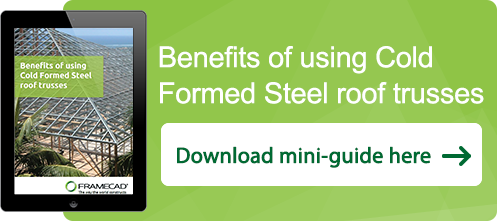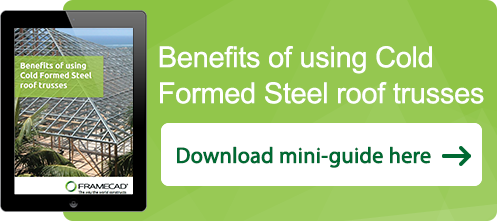
Quality assurance, and the sourcing of cost-effective, superior materials, is a primary concern in any modern building project. One approach that can make a substantial difference in project quality and efficiency is to use roof trusses made with cold formed steel (CFS).
CFS roof trusses work well for projects of any common size or scope. They are a very durable and cost-effective alternative to wood trusses, helping building owners and contractors around the world complete projects to the satisfaction and high standards of everyone involved.CFS is a light, very strong material that is effective for a wide range of construction applications. Roof trusses fabricated from CFS, in particular, have several advantages over the use of trusses made with wood.
We’ve put together a mini-guide exploring the benefits of CFS roof trusses in much more detail. Click the button to download our mini-guide.
Below, we’ll explain just a few of the reasons why CFS roof trusses are likely ideal for your next building project.
Applicable to a wide range of building projects, anywhere
CFS trusses are widely used in projects of various size and shape around the world. Be it a multi-story building, a hotel, a corporate office building, an academic institution, or a healthcare facility, CFS roof trusses are virtually unlimited in application.
As we explain further in the mini-guide, CFS trusses have been used in many locations for different reasons, from South East Asia where they’ve consistently proven superior and more resilient to wood-built trusses, to the Middle East, where they are now commonly used in both residential and commercial buildings.
CFS trusses can partly solve the problem of finding skilled labor or sourcing timber, saving both money, and time in geographical areas where specialized construction labor is scarce or wood sourcing is limited.
CFS trusses offer greater production accuracy and can be installed with greater ease by being lightweight, projects move forward even in locations where labor shortages or wood supply are common construction issues. In addition, exact specifications mean less waste and fewer concerns about onsite adjustments.
Better than wood, in more ways than one
CFS is not subject to many of the problems encountered with timber in construction.
CFS roof trusses are stronger and of consistent quality, designed with high accuracy with advanced software, more complex designs can be achieved.
In addition, CFS trusses are designed and prefabricated with extreme precision. After specification with our FRAMECAD process, each part is built exactly as needed and expected.
Finally, wood is subject to damage from weather conditions such as rain or snow. Particularly during the construction phase, this can cause costly delays. CFS trusses avoid this possibility, keeping project timelines on track.
Practically any type of roof can be built with CFS trusses
Roofs made of CFS trusses can fit any type of building. No matter the planned roof shape, CFS trusses can be designed and manufactured to achieve it. They can be fabricated to meet the requirements (including roof load) of a large choice of roof shapes, whether it’s a common hip roof, double fink, queen post, or a mono-pitched roof. This guide will also review the back-to-back vs inline trusses and the benefits of each design style.
Our mini-guide explains many of the types of roofs and trusses that are achievable using CFS. 








